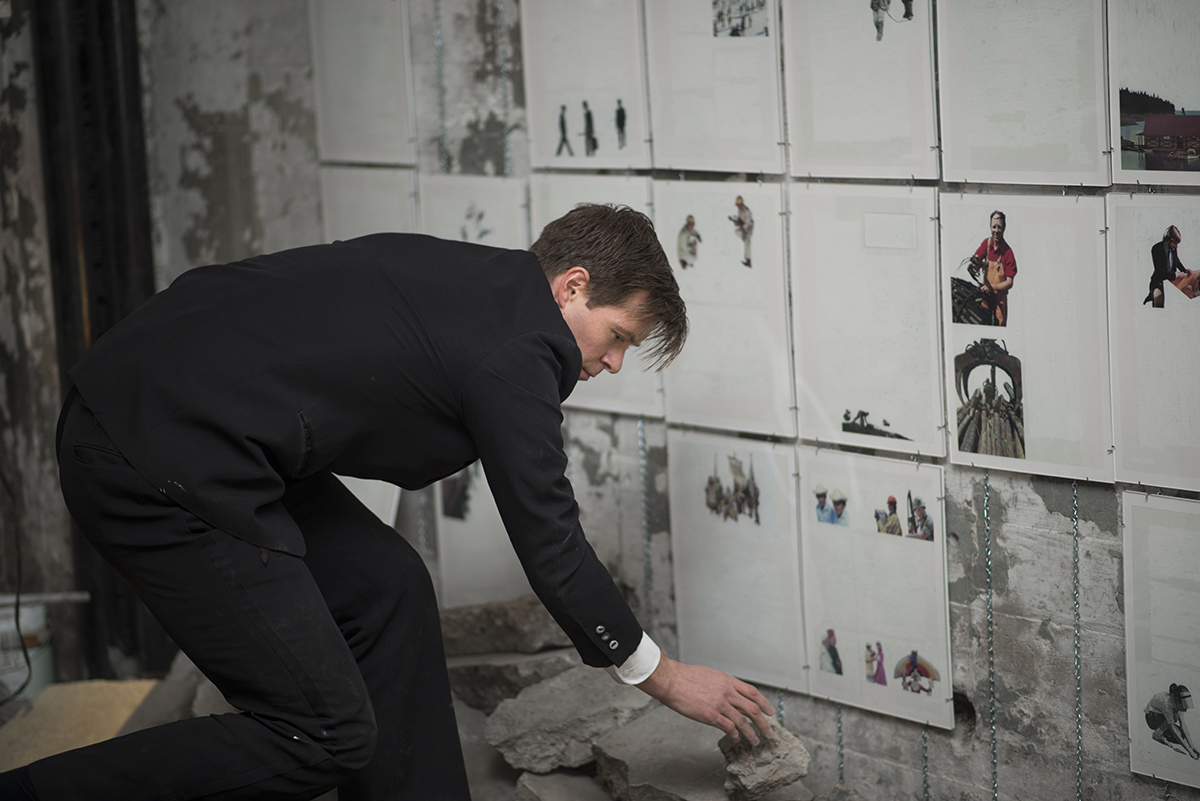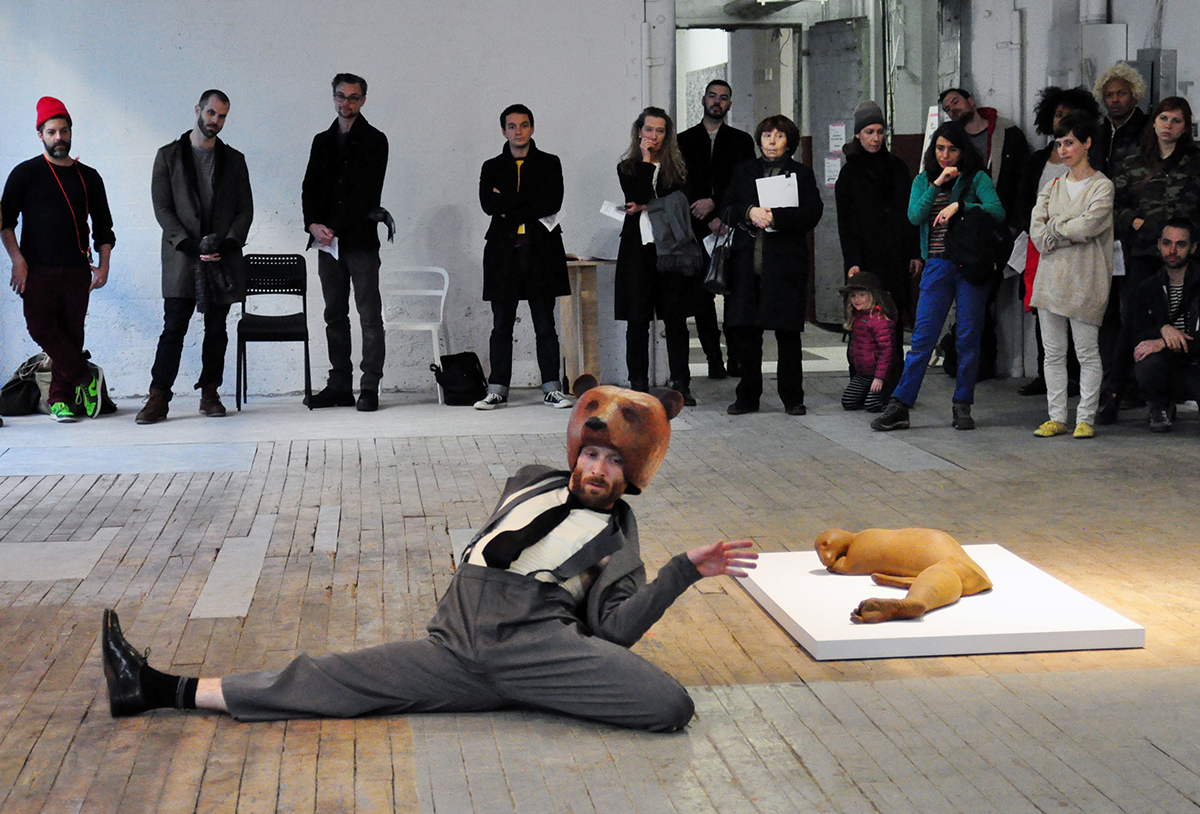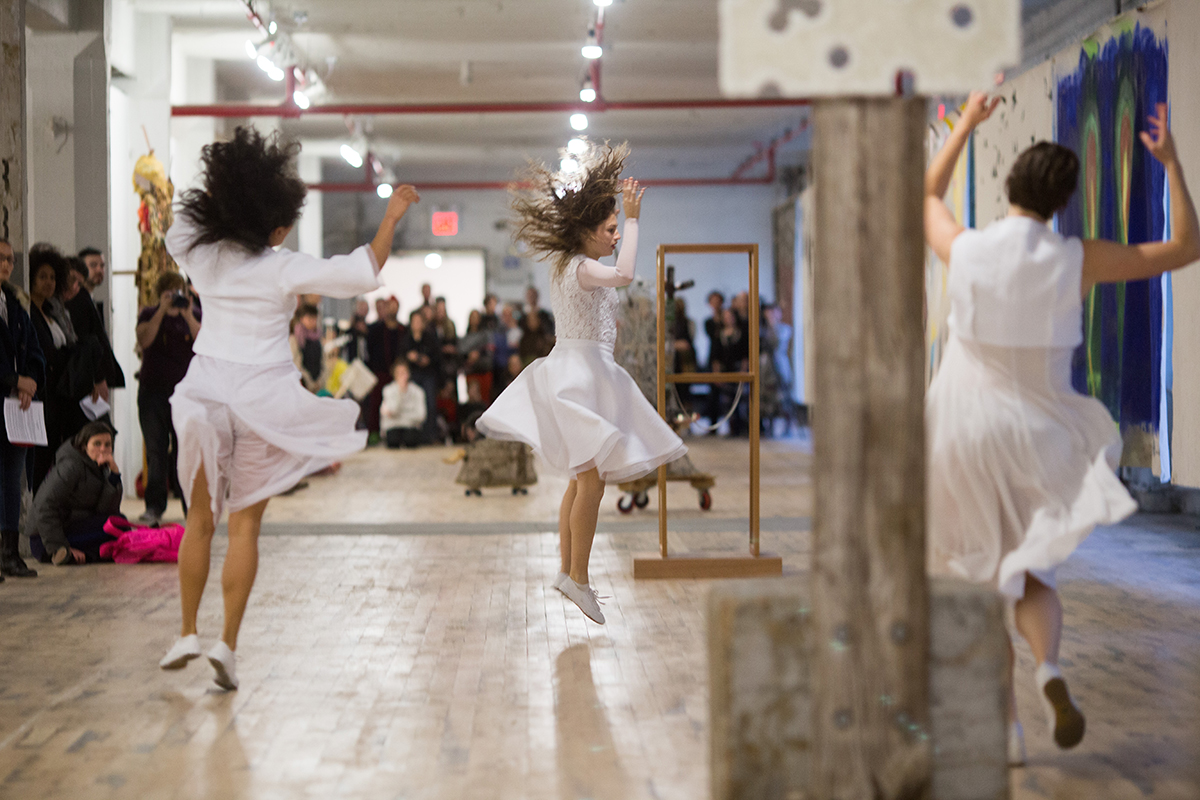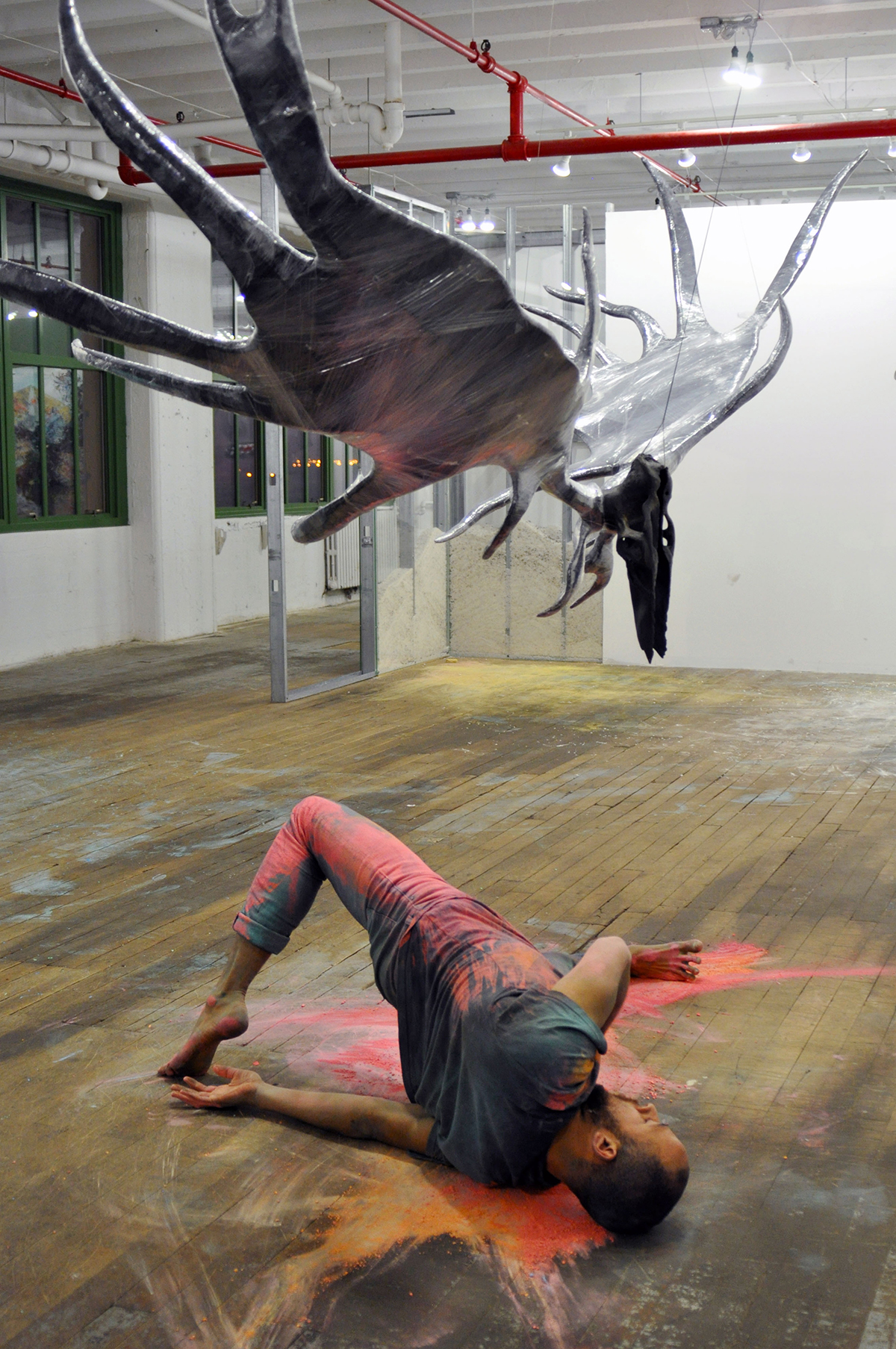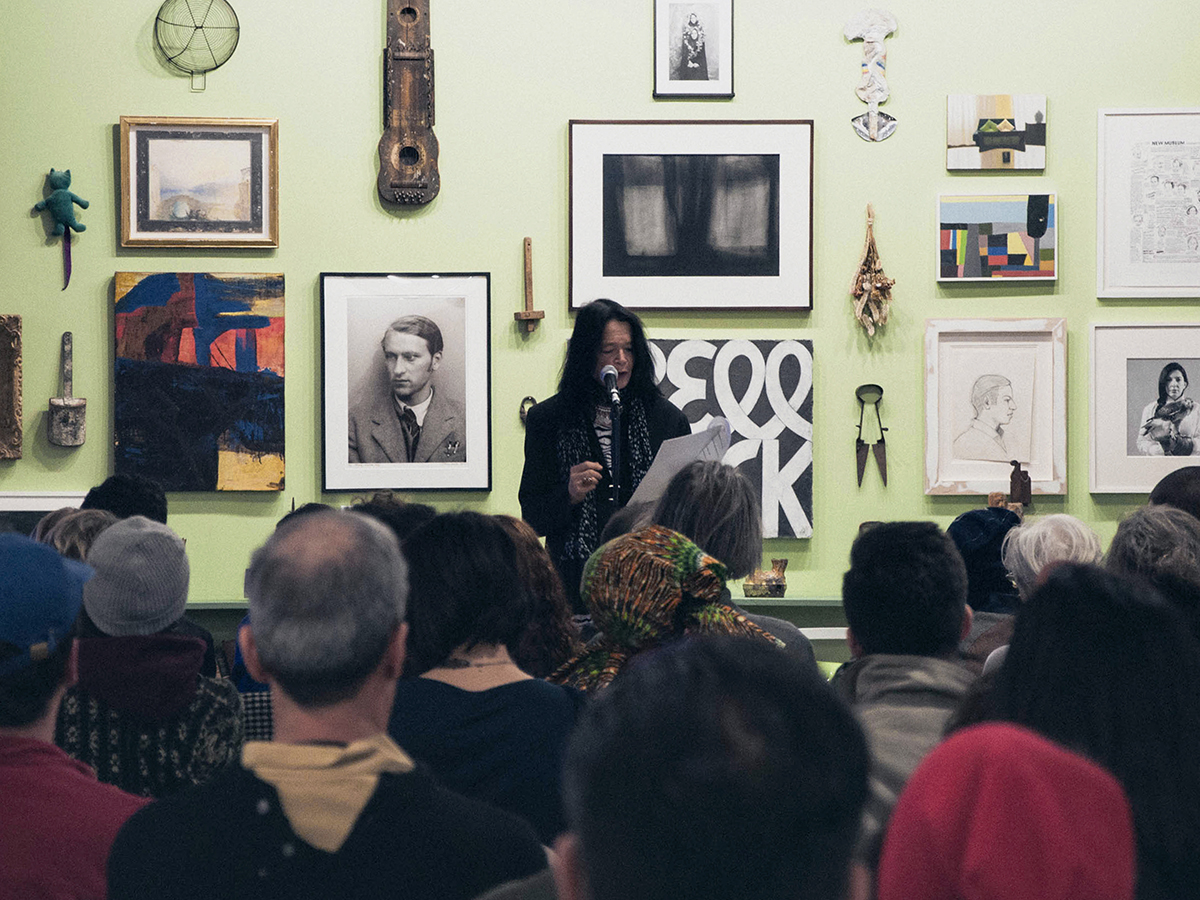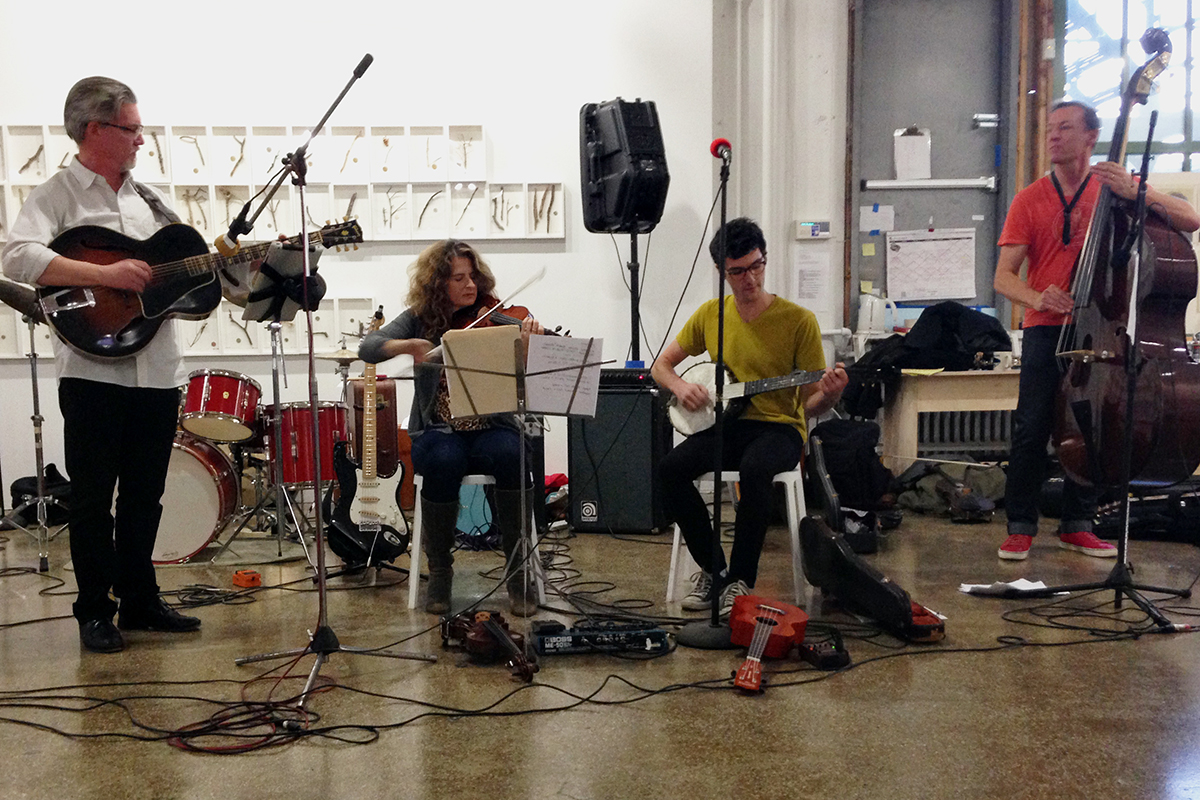The Poetry of Space
by Katy Rogers
“As the waters rise and rising keep on
Coming closer and then topping as winds
Swirl and the concoction pulls the children
Out of your arms and into the whale of air
The sky can break in your basement, the burglar
Alarm is not taking any more messages. Sweet
Pacific of Atlantic, the siren song salsas into
Your Lover’s arms. You will rise again, Brooklyn.”
-Bob Holman
Come Together: Surviving Sandy, Year 1 was never meant to be only an exhibition of visual art. From the first days of planning, everyone involved at both the Dedalus Foundation and the Brooklyn Rail wanted the galleries to serve as a forum for an expansive dialogue between the works on display and a variety of performances, literary readings, film screenings, and panel discussions. All of the organizers were deeply involved with all of the arts: this kind of broad engagement is one of the hallmarks of Phong Bui’s work, and for Dedalus it was an engagement that went all the way back to its founder, Robert Motherwell, who was deeply involved with poetry, music, and dance, as well as with the visual arts. So our decision to have the exhibition accompanied by varied programs of dance, music, and poetry reflected not only our personal interests but also a continuity of well-established traditions at both Dedalus and the Rail.
A number of questions became immediately apparent. How might a large and diverse community come together after tragedy, and what form might its expression of recovery take? How could we, the organizers of the exhibition, provide a creative support network for those who were affected? Expanding outward from the core idea of solidarity within both the art community and the greater community of New York City, Come Together became a stage for both artistic experimentation and exploration of how everyone affected by the experience of the storm might continue to grow stronger from this tragedy.
All of the events mounted during the exhibition were held in the galleries, surrounded by sculptures, paintings, installations, and videos. This lent a new dimension to the physical exhibition by activating the works and the spaces between works in new ways. The events were not only interesting in themselves but also gave rise to new interpretations and inspirations. This began as soon as the opening night, with performances of Josiah McElheny’s Walking Mirrors and Matthew Lange’s Archeology of the Plummet Machine Vol. 1 —very different kinds of interventions, both of which simultaneously reaffirmed the physical presence of the exhibition spaces and called into question their stability.
Artists in all mediums connected strongly to the environment, creating works that, like the spaces, were at once intimate and vast, and which gave rise to very particular kinds of performances.
The large, high-ceilinged industrial spaces of Industry City gave viewers a relationship to the work that was different from what might be experienced in the polished white cube of more traditional galleries and museums. The exhibition was infused with a sense of freedom and accessibility, which was enhanced by the unfinished floors and peeling concrete ceilings. Artists in all mediums connected strongly to the environment, creating works that, like the spaces, were at once intimate and vast, and which gave rise to very particular kinds of performances.
One of the most striking instances of this was Danspace Project’s presentation, Performing the Precarious, a two-part intervention into the galleries. The second part of this program was a series of dance events performed over several hours, in the changing light of a winter afternoon, on December 7. Conceived as “poems in space” by curator Judy Hussie-Taylor, this event included a number of different performances that were staged at the same time in different parts of the exhibition, and which were repeated in such a way that viewers could see most of them one after another and then go back and see repeat performances (several repeated three times during the course of that single day). Some were new works, created in specific response to the themes of the works in Come Together. Others were reinterpretations of earlier works, reconfigured in response to the new context. Rebecca Davis’s excerpts from will however happen, and Cori Olinghouse’s The Animal Suite: Experiments in Vaudeville and Shapeshifting, were excellent examples of works that had been created earlier and had been revised, and even transformed, for the new context in which they would be seen.
Michelle Boulé’s radiant performance, White, was a compelling example of a work that had been created earlier but which was dynamically altered by the gallery spaces. In White, three dancers dressed in diaphanous white dresses raced and weaved and spun through a very long and spacious gallery filled with sculptures by Rachel Beach, Ursula von Rydingsvard, Arthur Simms, Donald Moffett, and others. The space quite literally came alive: the inanimate works themselves seemed to dance from their bases and walls in response to the energy of the live dancers. Michelle Boulé has noted that she was “inspired by the life of the work in the galleries . . . The layout of the pieces created an already existing movement pattern that we could follow . . . We used various pieces as landmarks for the choreography . . . The choreography was very specific to that space.”
Will Rawls’s solo performance decumulation, which was staged around and underneath Michael Joo’s sculptural works, offered a more self-contained and introverted response to the exhibition spaces. Using many different colors of chalk, Rawls drew on the wood floors, while at the same time rolling around slowly on the floor, gymnastically at times, as he coated himself with more and more layers of colored chalk dust. This accretion and transfer of materials and gestures created a kind of call and response not only with Joo’s works, but also—by extension—with the whole exhibition.
In a very different vein, Rebecca Brooks’s three-hour long, continuous dance performance, YALA, delicately engaged very different surroundings. On the wall behind her was a series of austere black and white Richard Serra prints which she responded to with her own sensual, curvilinear movements, which in turn were echoed in a more direct way by the proximity of Ray Smith’s sculptures. Both dancer and sculptures seemed to roll and undulate throughout the space, which was in a sense “framed” by Serra’s rectilinear forms. Here, as elsewhere in the performances, movement was infused into the still spaces between the stationary artworks in such a way that both the dancers and the artworks came to be seen differently. The interplay between them became a kind of physical manifestation of the kind of artistic dialogue that underlay the conception of the exhibition itself.
Vast as they were, the exhibition spaces also allowed for warmth and intimacy—both for the works and for the performers. Xaviera Simmons’s performance of Yoko Ono’s riveting Cut Piece, the first part of Performing the Precarious, was an especially memorable example of what could be done with this kind of intimacy. Simmons had performed the piece before, but in larger, more traditional, stage-like settings. For Come Together she chose simply to sit on the floor in front of a windowed wall, on the same plane as the audience, dressed in a flowing brown dress. She and performance curator Lydia Bell of Danspace had selected Cut Piece as a response to the “devastation of Sandy and the vulnerability of humans and cities everywhere.” In this performance, members of the audience come forward at their own pace—often slowly, but sometimes decisively—and cut off pieces of the performer’s clothing. The austere and yet emotional way in which Simmons performed this piece made vividly tangible the deep intimacy that vulnerability can create between people. It explored something deeper as well: how human beings can make themselves less vulnerable by banding together, especially in moments of great stress or tragedy.
Come Together created a platform in which artists could learn from the tragedy and also grow more resilient.
Many artists found themselves either devastated or in extremely vulnerable situations in the aftermath of Sandy, which ruined studios, materials, and years worth of stored work. In the days immediately following the storm, a number of conservators came together to help artists salvage what they could. But the question remained, even a year later, of what preparations might have mitigated the losses suffered by artists. Many of those same conservators teamed up with the Craft Emergency Relief Fund (CERF+) to generate materials outlining how to prepare and protect a studio before a disaster strikes. CERF+ hosted a panel discussion on these matters in the Come Together galleries, highlighting the need to invest in thoughtful studio design, proper emergency procedures, adequate insurance, and relationships with conservators, which could provide artists with the means for navigating their way through catastrophic situations.
Although some might find it hard to address such issues after the fact, Come Together created a platform in which artists could learn from the tragedy and also grow more resilient. The International Network for the Conservation of Contemporary Art-North America (INCCA-NA) took on the difficult task of asking artists to speak openly and candidly about their losses and about how their vulnerability may have changed (or not changed) their studio practice.
Beginning on the opening night of the exhibition, and continuing every Saturday for the next two months, conservators affiliated with INCCA-NA conducted oral history interviews with artists who had been directly affected by Sandy. Even a full year later, some artists had not yet fully recovered, and at times bursts of raw emotion—even sobs—broke through the veneer of the interview format. It was instructive to see how varied the responses were. Some artists lingered on past losses. Others had chosen to push forward and not look back.
The wide range of emotional responses in these oral history interviews reflected the different ways in which various artists were able to explore the complex new realities that they had to face in their studio practices. The conservators, some independent and some from major institutions such as the Brooklyn Museum of Art and the Hirshhorn Museum and Sculpture Garden, subtly and sensitively inquired as to how the artists had dealt with the trauma of lost and damaged work. The hope was that by working together, artists could be better prepared, and conservators better equipped, to help artists deal with the next disaster. The best way to move forward and recover, they realized, was to learn from each other and to expand the support network, individual by individual.
Giving voice to the experience of Sandy did not always entail strict factual discussions and interviews. Some of the most powerful responses came through poetry. The Dedalus Foundation and the Brooklyn Rail commissioned a number of poets to respond either directly or indirectly to their experience of Sandy. The poems, which were read in the second floor gallery space, have been gathered together for a chapbook that is being published at the same time as this catalogue, as Oh Sandy: A Remembrance. This particular act of commemoration was a vivid instance of the ways in which beautiful and moving things may be born out of our darkest moments, and of the ways in which inspiration often comes from unexpected places. Some poets spoke plainly and directly of the storm while others evoked a sense of the personal, political, and social storms of our times. Perhaps most poignant were the poems that spoke directly to the loss of both life and art, as in Anne Waldman’s “If/Then: All Hallow’s Eve”:
if what we see if what we fear if what we inhabit the jealous gods the master narratives
the misplaced funds, the allocated ruins, prophetic ignorance. then what.
waves of detritus. the overturned house. the dismembered car. then, what. the torn
clothing. panicked mother. dead lines. then dead lines. dead lines. and some lives, dead.
if what we see we taste we touch the ransacked clothing. the destroyed archive, the
destroyed canvas, the plans awry. the rotting food. lights out for what message earth
might be telling us. then stop. then stop. shore of our city enfolded in thematic detail:
mask you wear, ghost you wear, fear you wear, edges you wear, the work you wear
if and then the art you make the poetry you stir up, could it be “gone” “lost” never return?
if, and then. if/then. what. value. what value. inestimable. “get over it.”
if you are not prepared. civic safety not there sanctuary not there, not there, but
foreshadow there then: what? where. and turn. where. loss is the discovery. safety,
what?
The theme of disaster as generative force was explored further in the panel Beyond Backdrop: Fiction in the Wake of History, where authors Joseph O’Neill, Lucy Alibar, and Alex Gilvarry discussed how they incorporated traumatic events into their fictionalized narratives. The organizers of the panel, co-editors of the Rail’s Books section, Katie Rolnick and Joseph Salvatore, chose the writers because their “work and process could provide context for the fictional stories that would inevitably arise in Sandy’s wake.” Each of the authors described how fact could play an important role in fiction, by adding depth and nuance through context, and by challenging readers to reassess their own personal experiences in relation to specific traumas.
Each of the events that were mounted during the course of the exhibition explored ways in which it might be possible to move beyond the uncertainties of living a creative life in a city like New York, where the unpredictable is constantly occurring, and where coping with the constantly changing physical, economic, and human landscapes is both a challenge and a source of inspiration to artists. Hurricane Sandy taught us that there is no one way to overcome disaster or even to prepare for it. But there are nonetheless many ways to learn from all sorts of disasters, large and small.
Over the course of the exhibition and all of its related events Come Together made it clear that community and dialogue lie at the heart of both surviving and thriving, and that, in the end, the sense of community is one of the most valuable assets that anyone in any city has to depend on. Beauty may emerge from catastrophe, and inspiration from trauma, but the strength to overcome and move forward emanates from coming together, as we prepare to face whatever may befall us in the future.
Events:
Thursday, October 17: Various performances at the Opening Reception
Red Head
Site-specific performance by Nathaniel Lieb (also performed at the closing reception on December 15)
Node: Within the Space of 7 Breaths III
Performance by Shawn Upton
Archeology of the Plummet Machine Vol. I
Site-specific performance by Matthew Lange (also performed at the closing reception on December 15)
Walking Mirrors
Josiah McElheny pieces activated by dancers (also performed at the closing reception on December 15 and at other times over the course of the exhibition)
Thursday, October 24: Screening of Beach 119 documentary
Directors: Marcie Allen and Jessica Beutler
Discussion with the directors and selected film subjects
Saturday, November 9: Screening of The Rider and the Storm and Shored Up documentaries
Directors of The Rider and the Storm: David Darg and Bryn Mooser
Q & A with director of Shored Up: Ben Kalina
Sunday, November 10: Children’s Poetry Workshop
Led by Christie Ann Reynolds
Sunday, November 10: Oh, Sandy: A Remembrance
Readings by poets commissioned to write about their experiences during Hurricane Sandy. Published as a chapbook by the Brooklyn Rail in 2014.
Poets: Charles Bernstein, Anselm Berrigan, LaTasha N. Nevada Diggs, Tonya Foster, Nada Gordon, Bob Holman, Erica Hunt, Paolo Javier, Pierre Joris, Vincent Katz, Erica Kaufman, Rachel Levitsky, Tan Lin, Tracie D. Morris, Anna Moschovakis, Bob Perelman, Anne Waldman, Elizabeth Willis, Matvei Yankelevich.
Thursday, November 14: Bedsport Fan Breathe
Performers: Dachi Dreaa, Candice Williams, and Whitney Vangrin
Sunday, November 17: Performing the Precarious, Part I: Cut Piece
Created by Yoko Ono and performed by Xaviera Simmons
Curator: Lydia Bell
Saturday, November 23: Keeping it Together: Thriving After Sandy (CERF+ Panel)
Panelists: Illya Azaroff, Jean Ann Douglas, and Anna Studebaker
Moderator: Craig Nutt
Sunday, November 24: Battle of the Artist Bands
Performers:
Ham with Steve Dibenedetto, David Humphrey, Michele Segre, and Jennifer Coates
Gospel of Barb with Steve Dibenedetto, David Humphrey, and Jon Kessler
Jeanne Get Around with Jennifer Coates, Stephen Ellis, David Humphrey, and Terry Dignan
Slip N’ Slide with Stephen Ellis, Ron Baron, and Scott Williams
Red with David Ross and Patrick Jones
Saturday, December 7: Children’s Dance Workshop
Led by Rebeca Medina and Tatyana Tenebaum
Saturday, December 7: Performing the Precarious, Part II: Day into Night
Curator: Judy Hussie-Taylor
YALA created and performed by Rebecca Brooks (6th floor)
will however happen (excerpts) created by Rebecca Davis and performed by Erin Cairns, Lydia Chrisman, Carolyn Hall, and Kay Ottinger (3rd floor)
decumulation performed by Will Rawls (3rd floor)
The Animal Suite: Experiments in Vaudeville and Shapeshifting (excerpt) created by Cori Olinghouse and performed by Neal Beasley (3rd floor)
Find Yourself Here created by Joanna Kotze and performed by Jonathan Allen and Joanna Kotze (6th floor)
White created by Michelle Boulé and performed by Michelle Boulé, Lauren Bakst, and Lindsay Clark (3rd floor)
Study for 13 Love Songs created and performed by Ishmael Houston-Jones and Emily Wexler (3rd floor)
Sunday, December 8: Hurricane Sandy and Damaged Artwork: The Artist’s Experience (INCCA-NA Panel)
Panelists: Rachel Beach, Diana Cooper, Magdalena Sawon, and Linda Serrone Rolon
Moderator: Elizabeth Nunan
Sunday, December 8: Beyond Backdrop: Fiction in the Wake of History (Fiction Writers Panel)
Panelists: Joseph O’Neill (author of Netherland), Lucy Alibar (screenwriter for Beasts of the Southern Wild), and Alex Gilvarry (author of Memoires of A Non-Enemy Combatant)
Moderators: Katie Rolnick and Joseph Salvatore
Every Saturday during the entire course of the exhibition, INCCA-NA conducted Oral Histories with artists who were victims of Sandy. Excerpts from these interviews are available on the website cometogethersurvivingsandy.org

